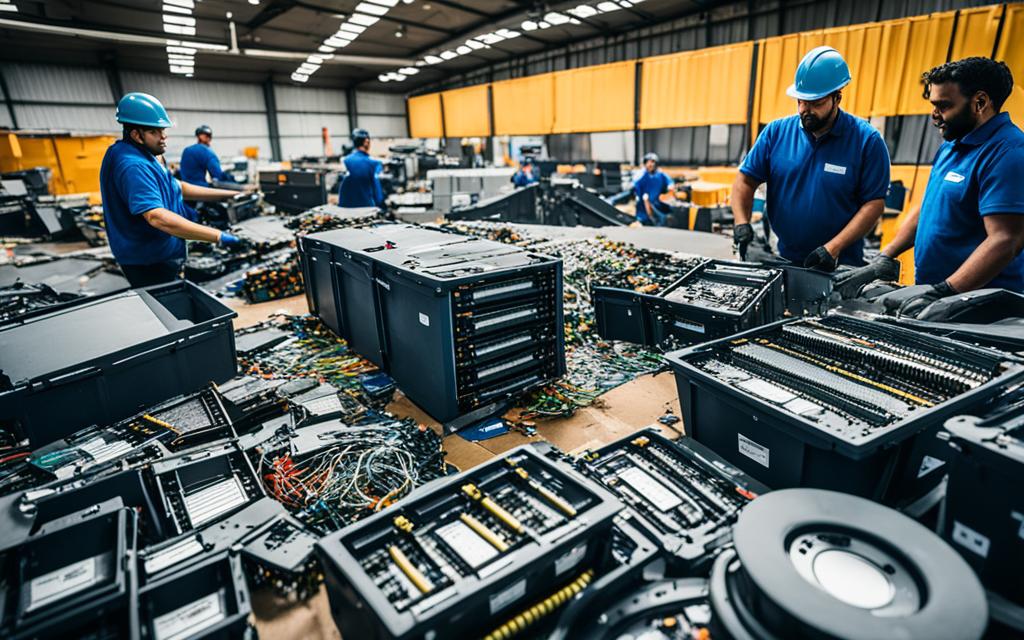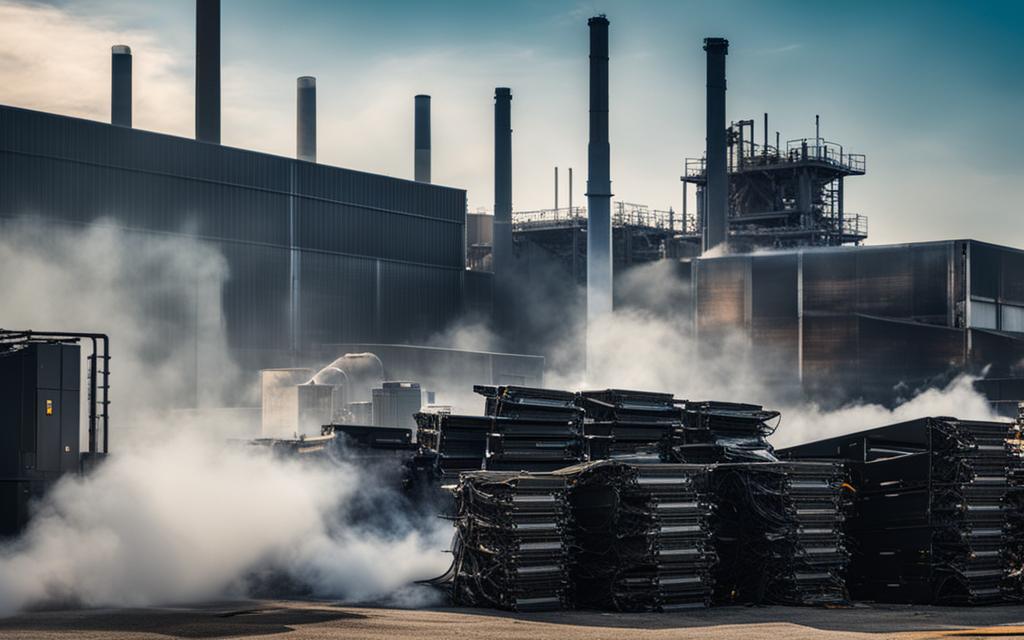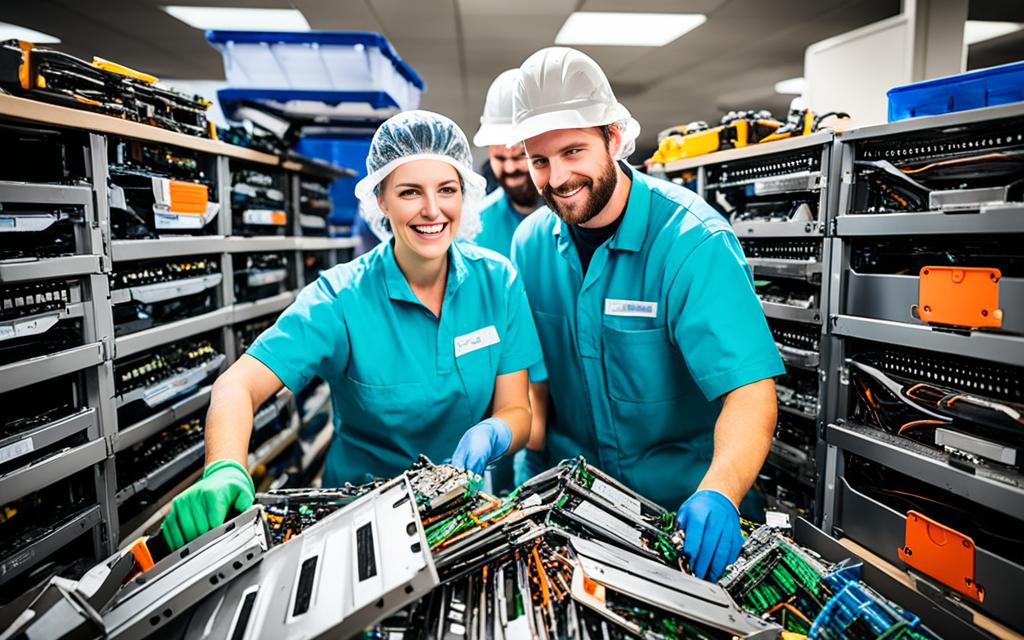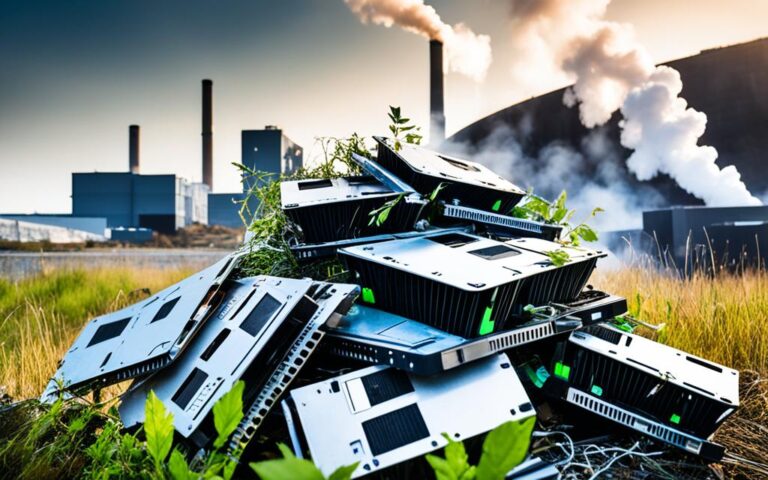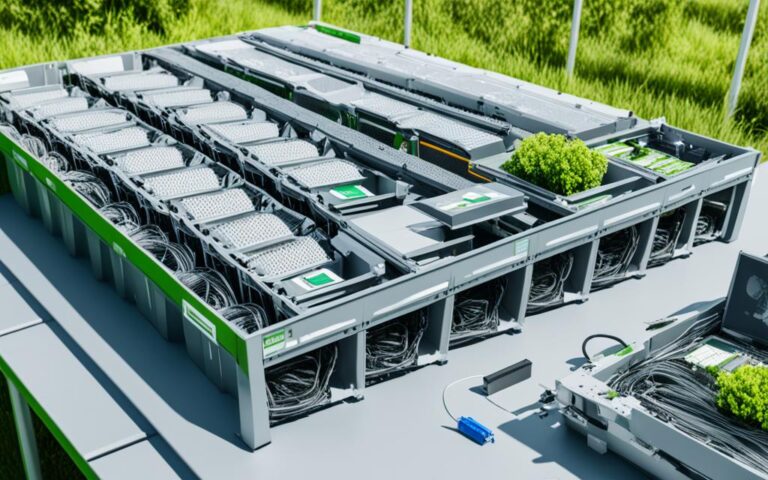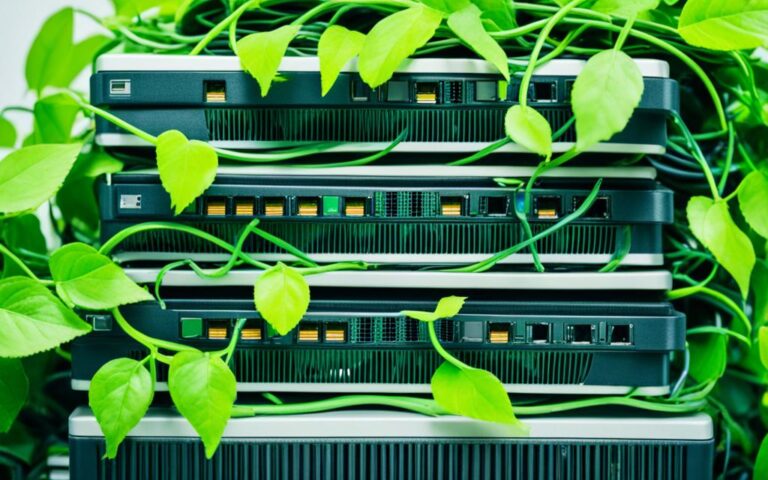Server Recycling: Challenges and Opportunities in Emerging Markets
Welcome to our insightful exploration of server recycling in emerging markets. In today’s fast-paced world, where technological innovation and shortened lifecycles of electronic equipment contribute to the growing issue of e-waste, it’s crucial to examine the challenges and opportunities associated with server recycling in emerging markets.
Did you know that global e-waste generation is estimated to reach a staggering 74.7 million metric tons by 2030? As the demand for electronic equipment continues to rise, so does the need for sustainable solutions to manage and recycle these devices. That’s where server recycling comes into play.
With emerging markets playing a significant role in the global economy, it’s essential to understand the unique challenges and opportunities they present for server recycling. Regulatory changes, the development of the repair economy, and the adoption of Industry 4.0 are just a few factors driving growth in server recycling within these markets.
In this article, we’ll delve into the role of refurbishment and reuse in server recycling, the importance of data security in the circular economy, and how Industry 4.0 can contribute to sustainable server recycling in emerging markets. By embracing the principles of the circular economy and leveraging the potential of emerging markets, we can turn the challenges of server recycling into growth opportunities for a more sustainable future.
The Role of Refurbishment and Reuse in Server Recycling
In the world of server recycling, refurbishment and reuse play a vital role in maximizing value recovery and minimizing waste. As we navigate the challenges and opportunities of the emerging market, it becomes increasingly important to explore sustainable solutions that extend the lifecycle of electronic equipment, including servers.
Refurbishment and repair services for servers and other electronic equipment are expected to see significant growth in the next five years. By refurbishing and restoring servers to their optimal condition, we can give them a second life and meet the demand for affordable and functional IT assets. This not only reduces electronic waste but also provides cost-effective solutions for businesses and individuals.
The European Commission estimates that there are around 700 million unused phones in Europe. This staggering figure sheds light on the potential for refurbishment and reuse across various IT asset categories, including servers. Companies like refurbed are leading the way in closing the loop by refurbishing and reselling electronics. They offer customers sustainable options for purchasing high-quality, pre-owned servers, creating a circular economy that benefits both the environment and the bottom line.
One key aspect of successful refurbishment and reuse is the development of a trackable business model. By adopting a system that allows for traceability and transparency, we can ensure that valuable materials and components stay within the region, maximizing value recovery from used servers. This not only reduces the need for raw materials but also fosters local economic growth and job opportunities.
Refurbishment and reuse are powerful tools in the journey towards a more sustainable server recycling process. By recognizing the value of unused equipment, embracing refurbishment services, and implementing trackable reuse models, we can make a significant impact on the reduction of electronic waste and the creation of a greener future.
Stay tuned for the next section, where we will explore the crucial role of data security in the circular economy of electronic equipment.
Data Security and the Circular Economy of EEE
The circular economy of electronic equipment (EEE) is heavily reliant on data security. Safe data destruction is a critical factor in ensuring the successful transition to refurbished and reused servers. However, concerns about data security hinder this transition, impeding the growth of the circular economy in server recycling.
To build trust and release more equipment into the second-hand economy, increased awareness of data sanitization technology and secure data destruction protocols is essential. By educating stakeholders about the effectiveness of these measures, we can alleviate concerns and promote the adoption of refurbished and reused servers.
TES, a leading IT asset disposition and recycling partner, understands the importance of data security in the circular economy. They utilize highly accredited data sanitization software solutions to ensure data protection and maintain a secure chain of custody throughout the recycling process.
Collaboration with companies like Blancco, a global software company specializing in secure data erasure, further enhances data security in the circular economy of server recycling. Together, they contribute to the development of robust data security practices and foster confidence in the reuse and refurbishment of servers.
“Data security is not just a concern; it is a key enabler for the circular economy of electronic equipment. By implementing stringent data sanitization measures and partnering with specialized companies, we can safeguard sensitive information and encourage the sustainable reuse of servers.”
Industry 4.0 and the Potential for Sustainable Server Recycling in Emerging Markets
In today’s rapidly evolving digital landscape, Industry 4.0, with its integration of advanced technologies in manufacturing, holds immense potential for driving sustainable server recycling practices in emerging markets. By harnessing the power of Industry 4.0, we can usher in a new era of environmentally conscious server recycling that aligns with the principles of circular economy and promotes long-term sustainability.
One of the key benefits of adopting Industry 4.0 in the supply chain management of server recycling is the ability to mitigate disruptions, improve productivity, and increase efficiency. The intelligent integration of digital technologies such as Internet of Things (IoT) devices, artificial intelligence (AI), and data analytics enables real-time monitoring and optimization of server recycling processes, leading to reduced downtime, enhanced resource utilization, and minimal environmental impact.
When assessing an economy’s readiness for implementing Industry 4.0 practices, the availability of digital infrastructure and robust big data analytics capabilities are crucial indicators. These foundational elements serve as the building blocks for leveraging the potential of emerging technologies, enabling effective data-driven decision-making and optimizing server recycling operations.
Although the diffusion of Industry 4.0 technology is currently low in emerging markets, significant growth opportunities exist driven by government policies, rising income levels, and greater global integration. By embracing Industry 4.0, emerging markets can leapfrog traditional linear economy models and implement sustainable server recycling practices from the outset.
Collaboration between data centre service providers and the server recycling industry is paramount to unleash the full potential of Industry 4.0 in emerging markets. Working hand-in-hand, these stakeholders can design and implement innovative solutions that improve environmental outcomes while creating new business opportunities. By combining expertise in digital technologies and server recycling processes, they can develop cutting-edge approaches that ensure the efficient recovery and repurposing of valuable server components, minimizing waste generation and promoting a circular economy of electronic equipment.
As we look to the future of server recycling in emerging markets, Industry 4.0 offers a pathway towards sustainable and efficient practices. By harnessing the transformative potential of digital technologies, we can revolutionize the server recycling landscape, driving economic growth, minimizing environmental impact, and creating a better world for generations to come.
| Benefits of Industry 4.0 in Sustainable Server Recycling |
|---|
| 1. Mitigation of disruptions in server recycling operations |
| 2. Improved productivity and efficiency |
| 3. Real-time monitoring and optimization of recycling processes |
| 4. Enhanced resource utilization and reduced environmental impact |
| 5. Leveraging digital infrastructure and big data analytics for effective decision-making |
Conclusion
Server recycling in emerging markets presents both challenges and opportunities for creating a more sustainable future. Despite regulatory gaps, short lifecycles, and inadequate waste management infrastructure, there is immense potential for growth in the reuse and recycling of servers.
Driven by regulatory changes, the development of the repair economy, and the adoption of Industry 4.0 technologies, collaboration and innovation within the server recycling industry are crucial. Through these efforts, we can maximize value recovery and minimize waste generation, paving the way for a greener and more sustainable future.
By embracing the principles of the circular economy and leveraging the untapped potential of emerging markets, we can turn the challenges of server recycling into valuable growth opportunities. It is time to come together, invest in sustainable practices, and transform the server recycling landscape. Together, we can create a world where sustainability is at the forefront of business decisions.
FAQ
What is the total global e-waste generation estimated to be in 2030?
The total global e-waste generation is estimated to reach 74.7 million metric tons in 2030.
How do technological innovation and shortened lifecycles contribute to the increase in e-waste volumes?
The speed of technological innovation and shortened lifecycles of electronic equipment lead to an increase in e-waste volumes.
Are there any start-ups offering sustainable solutions for extending the lifecycle of equipment?
Yes, consumers have started to understand the value of unused equipment, leading to the rise of start-ups offering secure and sustainable solutions for extending the lifecycle of equipment.
What does the 6P framework for Sustainability and Circular Economy emphasize?
The 6P framework for Sustainability and Circular Economy emphasizes the importance of policies, processes, people, products, partnerships, and platforms in driving growth opportunities in e-waste management.
What are some regulatory changes expected to drive growth in e-waste recovery and recycling infrastructure?
Some regulatory changes expected to drive growth in e-waste recovery and recycling infrastructure include the Ghana-Switzerland proposal and the Digital Product Passport proposed by the EU Commission.
What are the key drivers of value recovery and sustainability in server recycling?
The development of the repair economy and the re-commerce market are key drivers of value recovery and sustainability in server recycling.
What services are expected to witness growth momentum in the next five years in terms of electronic equipment refurbishment and repair?
Refurbishment and repair services for electronic equipment, including servers, are expected to witness growth momentum in the next five years.
Is the demand for second-life equipment high in various IT asset categories, including servers?
Yes, the demand for second-life equipment is high in various IT asset categories, including servers.
How many unused phones are estimated to be in Europe?
The European Commission estimates that there are approximately 700 million unused phones in Europe, highlighting the potential for refurbishment and reuse.
Are there any companies offering sustainable purchase decisions for customers through refurbishing and reselling electronics?
Yes, companies like refurbed are closing the loop by refurbishing and reselling electronics, offering sustainable purchase decisions for customers.
What can a trackable reuse business model help achieve in server recycling?
A trackable reuse business model can help keep valuable materials and components in the region, maximizing value recovery from used servers.
Why is safe data destruction important in the circular economy of electronic equipment?
Safe data destruction is critical to ensure data protection and secure chain of custody in the circular economy of electronic equipment.
What hinders the transition to refurbished and reused servers?
Concerns about data security hinder the transition to refurbished and reused servers.
How can increased awareness of data sanitization technology and secure data destruction protocols help in the circular economy of server recycling?
Increased awareness of data sanitization technology and secure data destruction protocols can help build trust and release more equipment into the second-hand economy.
Which company uses highly accredited data sanitization software solutions for data protection and secure chain of custody in IT asset disposition and recycling?
TES, a leading IT asset disposition and recycling partner, uses highly accredited data sanitization software solutions to ensure data protection and secure chain of custody.
How can collaboration with Blancco enhance data security in the circular economy of server recycling?
Collaboration with companies like Blancco, a global software company specializing in secure data erasure, can enhance data security in the circular economy of server recycling.
What is Industry 4.0 and how can it contribute to sustainable server recycling in emerging markets?
Industry 4.0 is characterized by the use of digital technologies in manufacturing and can contribute to sustainable server recycling in emerging markets.
How can the adoption of Industry 4.0 in supply chain management benefit server recycling?
The adoption of Industry 4.0 in supply chain management can help mitigate disruptions, improve productivity, and increase efficiency in server recycling.
What are some key indicators of an economy’s readiness for Industry 4.0?
The availability of digital infrastructure and big data analytics are key indicators of an economy’s readiness for Industry 4.0.
What are some challenges faced by server recycling in emerging markets?
Server recycling in emerging markets faces challenges such as regulatory gaps, short lifecycles, and inadequate waste management infrastructure.
Are there any opportunities for growth in the reuse and recycling of servers in emerging markets?
Yes, emerging markets present opportunities for growth in the reuse and recycling of servers, driven by regulatory changes, the development of the repair economy, and the adoption of Industry 4.0.
What can collaboration and innovation in the server recycling industry lead to?
Collaboration and innovation in the server recycling industry can lead to a more sustainable future, maximizing value recovery and minimizing waste generation.
How can we turn the challenges of server recycling into growth opportunities for a more sustainable future?
By embracing the principles of circular economy and leveraging the potential of emerging markets, we can turn the challenges of server recycling into growth opportunities for a more sustainable future.

